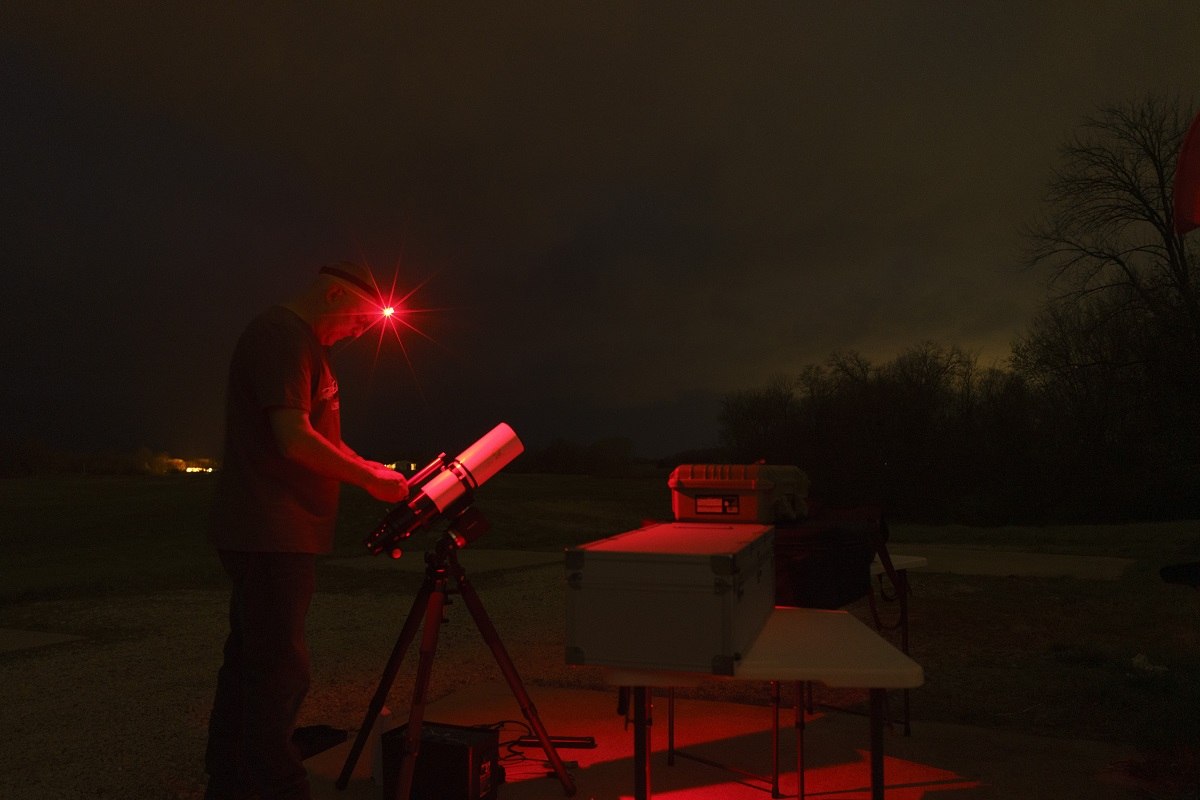
An eclipse enthusiast, Crystal Chadwick watched the Aug. 21, 2017, eclipse with friends and family from her home in Carbondale.
15:47 JST, March 24, 2024
No one in Crystal Chadwick’s family could understand why she was so giddy about the chance to see the moon completely cover the sun. As her family set up chairs at the end of their driveway just outside of Carbondale, Ill., in 2017, she oozed with excitement.
Then it happened – the moon draped the sky in premature darkness. The evening frogs croaked, the crickets chirped and everyone jumped out of their seats in amazement. And it’s about to happen again.
Seven years, two total solar eclipses, and roughly 1 in 10,000 odds. Being in the perfect place for the awe-inspiring solar eclipse is lucky, but being there again almost sounds improbable. For Chadwick and others who live in this small Illinois city calling itself the “eclipse crossroads of America,” this mystical experience is their reality.
On April 8, the moon will sweep across a 100-mile-wide path that stretches from Mexico through Maine and temporarily block the sun. It will cross Carbondale, just like it did on Aug. 21, 2017. Little fragments of Missouri, Illinois and Kentucky are also in the path of totality for both eclipses.
“It’s really the most beautiful thing I’ve ever seen in the sky, and I’ve been looking at the sky a long time,” said Chadwick, a former astronomy teacher and current NASA ambassador.
In anticipation of the celestial spectacle, the city is already buzzing. The college town of nearly 22,000 is ready to live up to its new namesake, “Carbondale: The Eclipse Crossroads of America.” Many hotel and other lodging options have been scarce for months. Eclipse shirts, cups and other merchandise have flooded local storefronts.
At the center of the planning is Southern Illinois University.
During the last eclipse, 15,000 excited skywatchers piled into SIU’s Saluki Stadium to watch totality in the town’s largest viewing spot. But some hearts were broken when darkness descended over the area: A cloud blocked the view of totality until the very last seconds of the event.
This time around, the school is prepared for a rain-or-shine event, said Bob Baer, co-chair of a committee that’s planned for both eclipses for the university. Live streams of the total solar eclipse as it hits totality across different locations on the path will be projected onto a jumbotron.
“It’s like preparing for a natural disaster that is coming, but it’s a positive event,” Baer said. He is ready to pack his multi-wavelength, solar telescope and travel to several local spots along the path to transmit live feeds if cloud coverage decides to play an antagonistic role.

Bob Baer is co-chair of a committee that’s planned for both eclipses for Southern Illinois University.
The university is scheduled to host NASA scientists who will participate in the school’s live eclipse broadcast to the world. Hundreds of eclipse-viewers will stay in an inactive residence hall that has been transformed into housing. And there will be solar-themed events throughout the day.
“It’s like going to Disneyland and you’re only going to spend one day,” Baer said. “You can’t actually get to everything here.”
To Chadwick, it feels especially welcome for so much fortune to fall on a place that’s felt down on its luck.
The college town is still adjusting to a dramatic downshift in the university’s enrollment, said Steven Mitchell, Carbondale’s economic development director. Nowadays, enrollment is just over 11,000 – down from over 24,000 in the 1990s.
During the last eclipse, exaggerated visitor predictions led city officials to plan for upward of 300,000 eclipse-goers. Overhyped crowd numbers deterred outside tourists and created hysteria among local residents, Mitchell said.
“People were scared to get out that weekend. People were buying their milk, bread, eggs and their prescriptions and all that,” Mitchell said, adding that some people “hunkered down” to avoid crowds.
In the end, only about 50,000 people traveled to Carbondale to gaze upon the sky. That still brought an estimated $8 million bump to the city’s revenue, Mitchell said.
Local restaurants thrived, some boasting all-time revenue peaks.
“We did get a nice uptick in business. However, I fell victim to the hysteria, ordered over 1,000 pounds of rice, extended our hours and didn’t have much to show for it,” said William Lo, whose family owns a popular Chinese restaurant in the city.
City officials and local businesses also planned for visitors to arrive in the days leading up to the eclipse and stay for days after. That didn’t happen. Instead, many visitors arrived the evening before the eclipse and left right after.
Fast-forward seven years later, and city officials aren’t sure about the number of people to expect at this year’s eclipse. Carbondale was the point of longest totality duration during the last solar eclipse with two minutes and 40 seconds. This time around, totality is four minutes and nine seconds – nearly double the last show but not the longest duration in the country. Many suspect that there could be a similar turnout to the 2017 crowd.
Now that people in the small city have seen an eclipse and hosted eclipse-goers, it seems many have plans and backup plans.
Chadwick has two backup plans in case inclement weather ruins her Carbondale farm barbecue. She is expected to host 20 people – many from surrounding states.
“It just seems like a double lottery win for me,” Chadwick said.
"News Services" POPULAR ARTICLE
-

American Playwright Jeremy O. Harris Arrested in Japan on Alleged Drug Smuggling
-

Japan’s Nikkei Stock Average as JGB Yields, Yen Rise on Rate-Hike Bets
-

Japan’s Nikkei Stock Average Licks Wounds after Selloff Sparked by BOJ Hike Bets (UPDATE 1)
-

Japan’s Nikkei Stock Average Buoyed by Stable Yen; SoftBank’s Slide Caps Gains (UPDATE 1)
-

Japanese Bond Yields Zoom, Stocks Slide as Rate Hike Looms
JN ACCESS RANKING
-

Tokyo Economic Security Forum to Hold Inaugural Meeting Amid Tense Global Environment
-

Keidanren Chairman Yoshinobu Tsutsui Visits Kashiwazaki-Kariwa Nuclear Power Plant; Inspects New Emergency Safety System
-

Imports of Rare Earths from China Facing Delays, May Be Caused by Deterioration of Japan-China Relations
-

University of Tokyo Professor Discusses Japanese Economic Security in Interview Ahead of Forum
-

Japan Pulls out of Vietnam Nuclear Project, Complicating Hanoi’s Power Plans
























